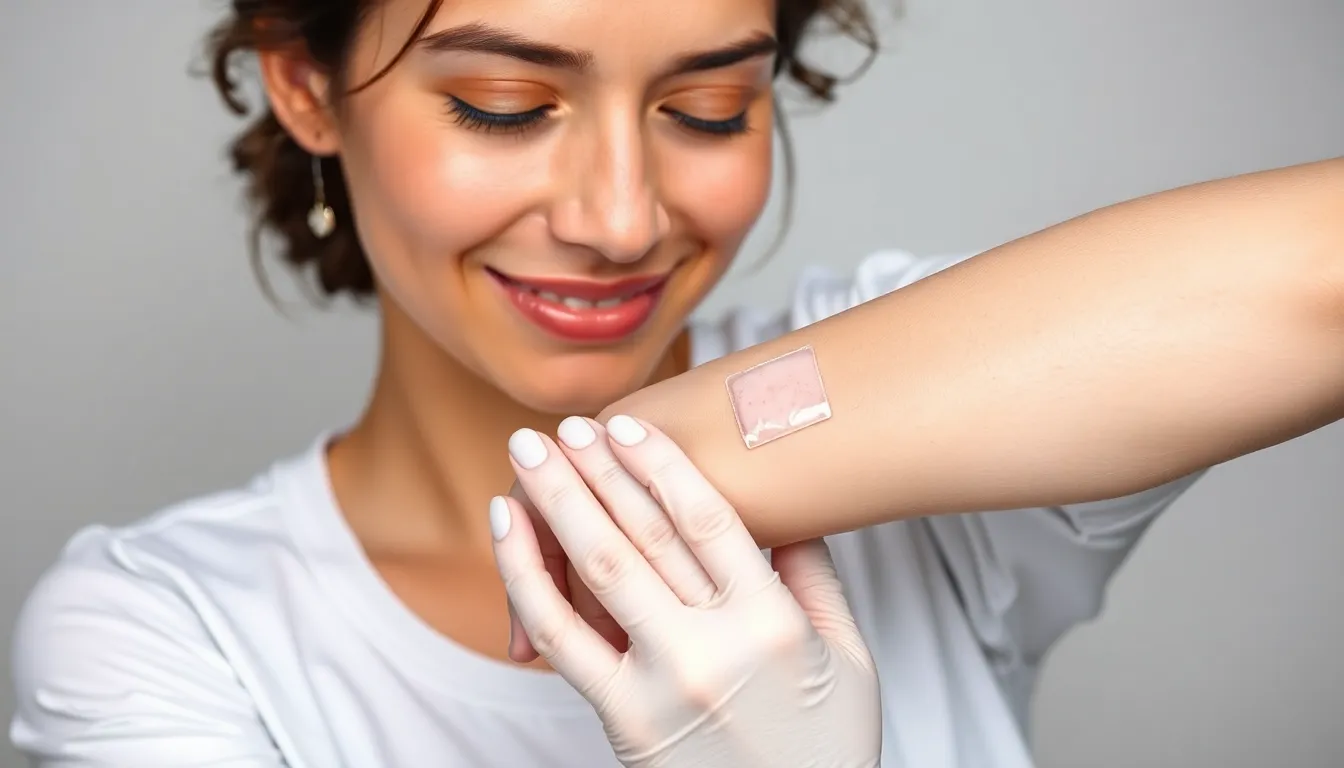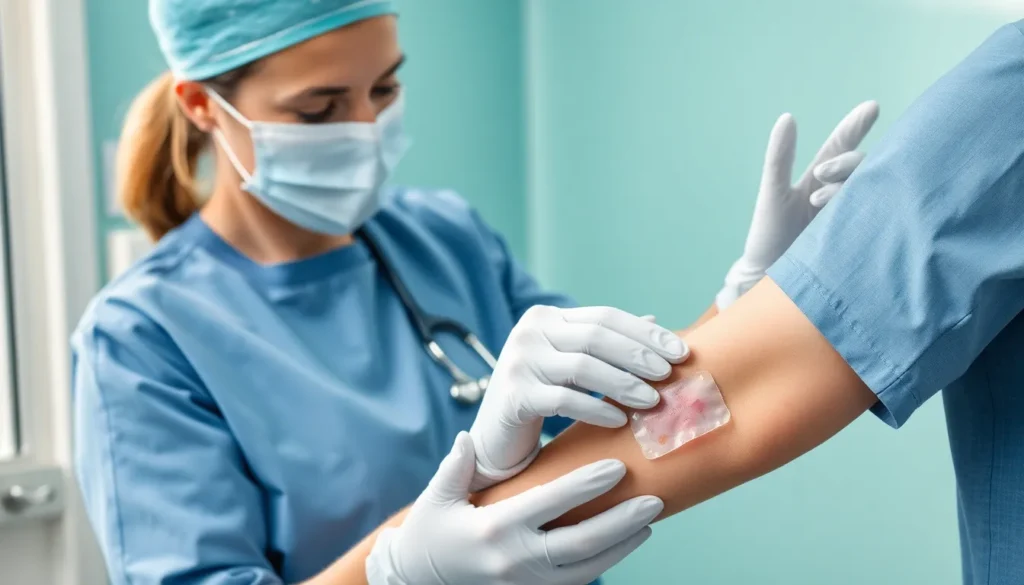Hydrocolloid dressings are like the superheroes of wound care, swooping in to save the day with their moisture-retentive powers. They’re perfect for blisters, minor burns, and even some chronic wounds. But just like every superhero, there comes a time when they need to hang up their cape. Knowing when to stop using hydrocolloid dressings can be a bit tricky, but fear not—this guide will help you navigate the winding road of wound management.
Table of Contents
ToggleOverview of Hydrocolloid Dressings
Hydrocolloid dressings provide a unique approach to wound care due to their moisture-retentive qualities. They create a gel-like environment, which enhances healing by keeping wounds moist. These dressings are particularly effective for blisters and minor burns, as they protect the area while promoting natural recovery. Certain types of chronic wounds also benefit from their use, as hydrocolloid dressings accommodate exudate and minimize pain.
Composition varies among different brands. Typically, these dressings contain a mixture of polymer and gel-forming agents, allowing them to absorb moisture while remaining in place. They adhere well to the skin, reducing the risk of secondary infections. Application is simple, making them a popular choice for both professionals and individuals managing wounds at home.
Despite their advantages, awareness of when to discontinue use is essential. Signs such as excessive exudate, odor, or visible necrosis indicate the need to stop using hydrocolloid dressings. Regular monitoring helps ensure that wounds stay healthy and free from complications. Consulting with a healthcare professional lends additional support in making informed decisions regarding the ongoing use of these dressings.
Optimal wound care involves recognizing both benefits and limitations. Understanding the function of hydrocolloid dressings aids in maximizing their effectiveness while minimizing potential risks associated with prolonged use.
Benefits of Hydrocolloid Dressings

Hydrocolloid dressings offer numerous advantages in wound care. They create a moist wound environment that accelerates healing, especially for blisters and minor burns. Comfort enhances due to their gel-like composition, which reduces pain during dressing changes.
Moisture retention promotes optimal healing while accommodating varying levels of exudate. They protect wounds from external contaminants, reducing the risk of infection significantly. Adhesion to the skin proves reliable, ensuring the dressing stays in place even in active areas.
Using hydrocolloid dressings simplifies wound management at home or in clinical settings. The transparent nature of some brands allows for easy monitoring without frequent changes. This transparency also helps individuals track progress without disrupting the healing process.
Hydrocolloid dressings are typically user-friendly. Application requires minimal training, making it accessible for both healthcare professionals and patients.
Consulting with healthcare practitioners can clarify which types are suitable for specific wound situations. Regular assessments allow for timely intervention if healing does not progress as expected. Overall, the effective moisture management and protective qualities of hydrocolloid dressings contribute greatly to successful wound care.
Indications for Use
Hydrocolloid dressings serve specific wound care needs. Understanding when to apply them optimizes healing outcomes.
Types of Wounds
These dressings work effectively on various wound types, particularly minor burns, blisters, and superficial abrasions. Acute wounds benefit from the moisture-retentive environment hydrocolloids create. Chronic wounds like pressure ulcers and diabetic ulcers also respond well, provided the exudate levels remain manageable. Observations indicate that hydrocolloid dressings perform best on clean, non-infected wounds. Presence of heavy exudate may compromise their effectiveness, signaling the need to reassess wound care strategies.
Severity of Condition
Classification of the wound’s severity significantly influences dressing choice. Minor injuries generally tolerate hydrocolloid dressings without complications. In contrast, severe wounds, exhibiting necrosis or significant bleeding, often require advanced care techniques. Healthcare professionals recommend reassessing these cases frequently. Additionally, if signs of infection like increased redness or warmth are present, discontinuation of hydrocolloid dressings becomes necessary. Close monitoring ensures optimal healing and prevents complications associated with inappropriate dressing choices.
Signs It’s Time to Stop Using Hydrocolloid Dressing
Recognizing when to stop using hydrocolloid dressings is crucial for effective wound care. Several indicators signal the need to discontinue use.
Wound Healing Progress
Wound healing progress can determine the effectiveness of hydrocolloid dressings. If the wound appears stagnant or worsens after several days, it’s time to reassess. Continual monitoring yields valuable insights. Check for a lack of improvement in size or discharge, as these factors highlight the potential need for a change in dressings. Hydrocolloid dressings might not support optimal healing in specific cases, particularly if exudate levels become excessive.
Signs of Infection
Signs of infection include increased redness, warmth, or swelling around the wound. If there’s an unusual odor or pus, these symptoms call for immediate attention. Infection can compromise healing and increase the risk of complications. Discontinuing hydrocolloid dressings in response to these signs is essential for proper management. Prompt intervention prevents further issues and allows for adequate treatment options to be implemented.
Changes in Wound Characteristics
Changes in wound characteristics can indicate the need to stop using hydrocolloid dressings. A transition from clear exudate to thick, colored discharge may suggest a problem. New tissue formation or a change in the wound’s surface may also suggest the dressing no longer fits the wound’s needs. Furthermore, if the skin surrounding the wound shows signs of irritation or maceration, adjusting the dressing approach becomes necessary.
Alternatives to Hydrocolloid Dressings
When hydrocolloid dressings are no longer suitable, alternatives exist that may provide effective wound care.
Other Dressing Types
Foam dressings offer excellent absorption for highly exudative wounds and provide cushioning. Gauze dressings can serve various wound types but may require frequent changes to manage moisture. Films provide a barrier to water and bacteria while allowing for visibility, making them useful for superficial injuries. Alginate dressings, derived from seaweed, excel in managing heavy exudate and promote a moist healing environment. Each dressing type offers unique characteristics tailored to specific wound care needs.
When to Consult a Healthcare Professional
Significant changes in a wound may require professional evaluation. Increased redness, warmth, or swelling often signifies infection that necessitates intervention. If healing does not occur within a few days or if necrotic tissue appears, immediate consultation becomes crucial. Healthcare professionals can provide tailored guidance based on wound characteristics and individual patient needs. Regular check-ups ensure appropriate management and help prevent complications.
Recognizing when to stop using hydrocolloid dressings is crucial for effective wound management. Signs such as excessive exudate, odor, or visible necrosis should prompt immediate reassessment. Regular monitoring of the wound’s condition allows for timely interventions and prevents complications.
When hydrocolloid dressings no longer serve their purpose, exploring alternative dressing options is essential. Each type of dressing offers unique benefits tailored to specific wound needs. Consulting with a healthcare professional ensures that individuals receive the best guidance for their situation. Prioritizing proper wound care not only enhances healing but also minimizes the risk of infection and other complications.





